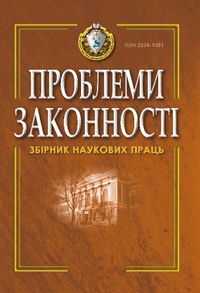Legal status of human biomaterial
DOI:
https://doi.org/10.21564/2414-990X.156.254433Keywords:
biomaterial, human body, thing, speech-legal nature, object of law, property rightsAbstract
The article is devoted to one of the urgent and topical problems of medical law, the problem of determining the legal status of human biological material. The changes taking place today in medicine and genetics open up a number of new opportunities for the study of man, his body and its use. Man has long been seen by science not so much as a "spiritual" value, but as a value as an "object of study" and an "object of experiment". No one denies the material essence of human organs, tissues, their ability to be the subject of a number of civil law transactions (purchase, sale, mines, storage, transportation, etc.). All this requires the legislator to look at human biological material in a new way. The law must respond to all these changes that are taking place in society, in the form of regulation of these benefits, the absence of which we see today. Public relations are developing much faster than the corresponding changes in legislation. The law can help the development of these relations, properly regulating them, and can slow down this process, which is currently happening in Ukrainian law. However, the law cannot stop the process of using human biomaterial, which has long begun. Thus, the purpose of the article is to consider the legal status of human biological material, to determine its place among the existing objects of civil rights. It is proved that the current level of development of medicine, genetics requires a new approach to the study of human biological material, its legal status and place in the system of modern civil law, which determines the relevance of the chosen research topic. Unfortunately, the legislation of Ukraine and most foreign countries does not recognize biomaterial separated from humans as an object of civil rights. However, the author concluded that the subject of a number of transactions, separated from human biomaterial, is no longer an "integral" part of the body, which only confirms the need to consider it as an independent object of civil law, which by its characteristics (material (physical) separation and the ability to act as a commodity in civil circulation) "tends" to the category of things, which is the novelty of this work.
References
Talidomid: ot chudodejstvennogo lekarstva do medicinskoj katastrofy. URL: https://www.chemwatch.net/ru/blog/thalidomide-from-wonder-drug-to-medical-disaster/ [in Russian].
Konventsiia pro zakhyst prav i hidnosti liudyny shchodo zastosuvannia biolohii ta medytsyny: Konventsiia pro prava liudyny ta biomedytsynu: Mizhnarodnyi dokument. Oviedo, 04.04.1997 r. (1997). URL: https://zakon.rada.gov.ua/laws/card/994_334 [in Ukrainian].
Cyvilnyj kodeks Ukrainy: Zakon Ukrainy vid 16.01.2003 r. № 435-IV. (2003). URL: https://zakon.rada.gov.ua/laws/show/435-15#Text [in Ukrainian].
Osnovy zakonodavstva Ukrainy pro ohoronu zdorovja: Zakon Ukrainy vid 19.11.1992 r. № 2801-XII. (1992). URL: https://zakon.rada.gov.ua/laws/show/2801-12#Text [in Ukrainian].
Pro zastosuvannia transplantatsii anatomichnykh materialiv liudyni: Zakon Ukrainy vid 17.05.2018 r. № 2427-VIII. (2018). URL: https://zakon.rada.gov.ua/laws/card/2427-19 [in Ukrainian].
Trubina, V.A. (2020). Tkani i organy cheloveka kak obіekty grazhdanskih prav. Moscow: Infotropik Media [in Russian].
Doodeward v. Spence [1908]. URL: http://www8.austlii.edu.au/cgi-bin/viewdoc/au/cases/cth/HCA/1908/45.html?stem=0&synonyms=0&query=title%28doodeward%20and%20spence%20%29.
R v. Kelly and Lindsay [1998]. URL: https://www.lawteacher.net/cases/r-v-kelly-and-lindsay.php.
Theft Act 1968 UK. Section 4(1). URL: http://www.legislation.gov.uk.
Re Organ Retention Group Litigation [2005]. URL: https://webstroke.co.uk/law/re-organ-retention-group-litigation-2005.
Dobson and another v. North Tyneside Health Authority and another [1996]. URL: https://www.bailii.org/ew/cases/EWCA/Civ/1996/1301.html.
Moor v. Regents of The University of California. URL: https://www.casebriefs.com/blog/law/property/property-law-keyed-to-cribbet/non-traditional-objects-and-classifications-of-property/moore-v-regents-of-the-university-of-california-2/.
Hodyko, Ju.E. (2015). Obyekt prava i obyekt grazhdanskogo pravootnoshenija. Har’kovskaja civilisticheskaja shkola: obyekty grazhdanskih prav – Kharkiv civil school: objects of civil rights. I.V. Spasibo-Fateeva (Ed.). Kharkov: Pravo, part. 2, ch. 1, 70–85 [in Russian].
Pro pidvyshchennia rivnia oplaty zdachi donoramy krovi ta (abo) yii komponentiv: Postanova Kabinetu Ministriv Ukrainy vid 27.12.2006 r. № 1821. (2006). URL: https://zakon.rada.gov.ua/laws/show/1821-2006-п#Text [in Ukrainian].
Gaj. Institucii (1891). F. Dydynskij (Transl.). Varshava: Tipografija K. Kovalevskogo [in Russian].
Spasybo-Fatieieva, I.V. (2015). Vydy ob’iektiv tsyvilnykh prav. Chasopys tsyvilistyky – Journal of Civilization, issue 18, 13–18. URL: http://dspace.onua.edu.ua/bitstream/handle/11300/8269/Chasopys%2013-18.pdf.pdf?sequence=1&isAllowed=y [in Ukrainian].
Suhanov, E.A. (2021). Veshhnoe pravo: nauchno-poznavatel’nyj ocherk Moscow: Statut [in Russian].
Zakhyst vlasnosti : posibnyk zi st. 1 Protokolu № 1 Konventsii pro zakhyst prav liudyny ta osnovopolozhnykh svobod. O. Drozdov ta in. (Transl.). URL: https://www.echr.com.ua/publication/zaxist-vlasnosti-posibnik-zi-st-1-protokolu-1/ [in Ukrainian].
Druzhinina, Ju.F. (2017). Pravovoj rezhim jembriona in vitro. Zhurnal rossijskogo prava – Journal of Russian Law, 12, 129–135. URL: https://cyberleninka.ru/article/n/pravovoy-rezhim-embriona-in-vitro/viewer [in Russian].
Pro zatverdzhennia Poriadku zastosuvannia dopomizhnykh reproduktyvnykh tekhnolohii v Ukraini: Nakaz Ministerstva okhorony zdorovia Ukrainy vid 09.09.2013 r. № 787. (2013). URL: https://zakon.rada.gov.ua/laws/show/z1697-13#Text [in Ukrainian].
Koncepcija onovlennja cyvilnogo kodeksu Ukrainy. (2020). Kyiv: Vyd. dim «ArtEk» [in Ukrainian].
Downloads
Published
How to Cite
Issue
Section
License
Copyright (c) 2022 Наталія Василівн Коробцова

This work is licensed under a Creative Commons Attribution 4.0 International License.










